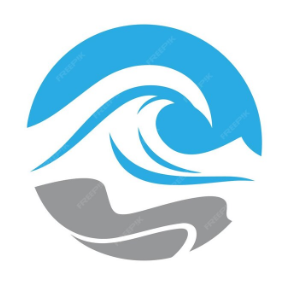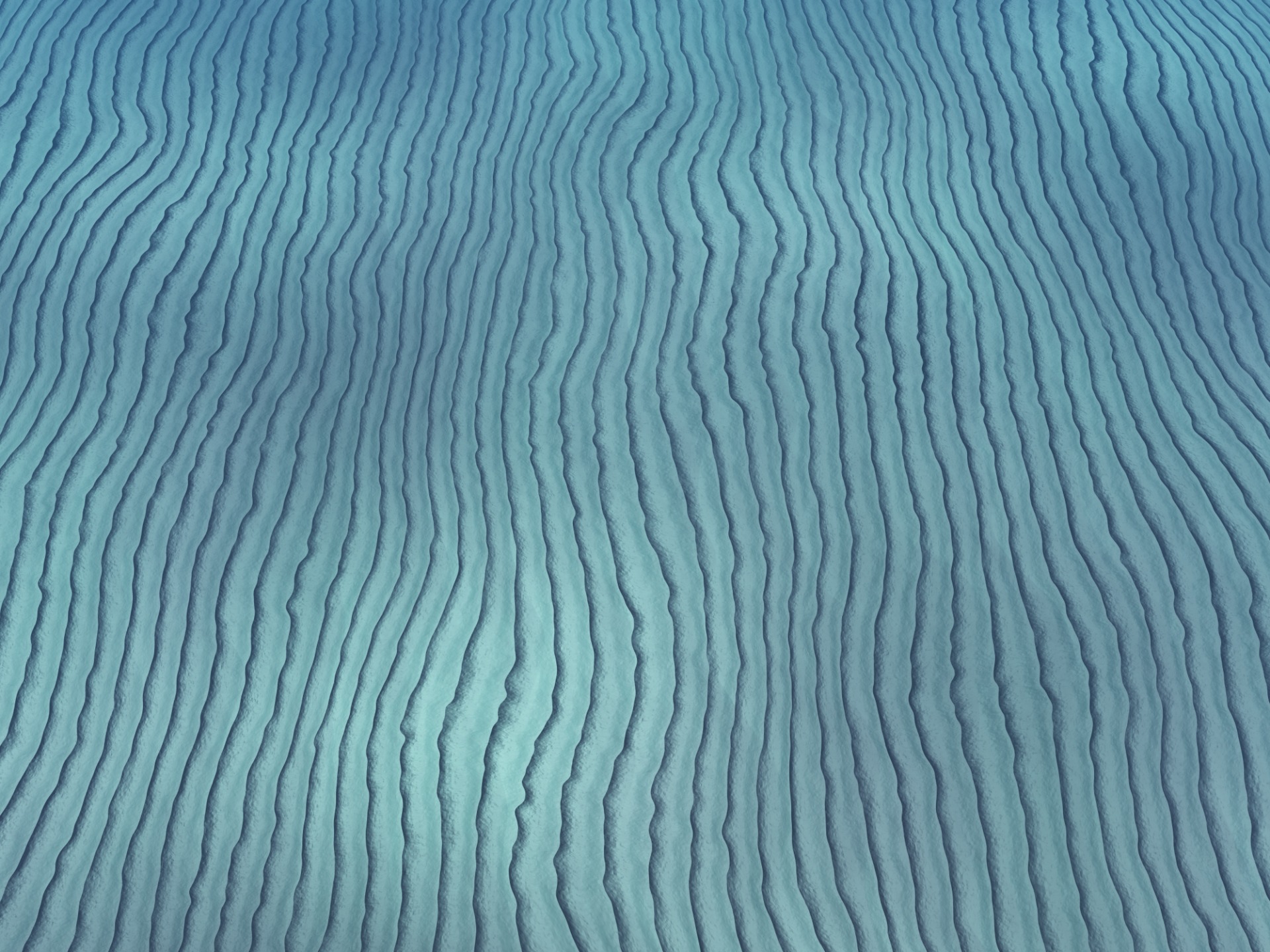Recherche / Research
Bedforms (Dunes, ripples), sediment transport, Machine Learning, nature based solutions / Formes de fond (dunes, rides), transport sédimentaire, Machine Learning, solutions fondées sur la nature
In the news: The DUNAMICS project on the study of submarine dunes has been awarded the Marie Curie Horizon 2020 fellowship. It will take place between New Zealand and Denmark during the period 2022-2025. See the dedicated DUNAMICS project page.
Dans l'actualité : Le projet DUNAMICS sur l'étude des dunes sous-marines a été lauréat de la bourse Marie Curie Horizon 2020. Il se déroulera entre la Nouvelle Zélande et le Danemark sur la période 2022-2025. Voir la page dédiée au projet DUNAMICS.
Professeur H.A. Einstein: "Mon père s'est très tôt intéressé au transport des sédiments et à la dynamique des rivières, mais après mûre réflexion, il a préféré opter pour des aspects plus simples de la physique"
Professor H.A. Einstein: "My father had an early interest in sediment transport and river mechanics, but after careful thought opted for the simpler aspects of physics"
English (French below)
Bedforms
This research axis focuses on the study of the evolution of submarine dunes. Understanding the evolution of submarine dunes is an important challenge for predicting flow circulation, sediment transport, and bathymetric variations in subaqueous environments. Although sand dunes represent significant scientific and operational interest (offshore structures, navigation, etc.), their evolution is still poorly understood due to their complex behavior. Important open questions remain, particularly concerning the physical mechanisms that lead to the equilibrium of dunes under different types of hydrodynamic conditions, as well as the dimensions of equilibrium dunes. Various parameters seem to come into play, whether it involves the confinement of the water column, the inertia of suspended sediment transport, or the nature of the sediments. To study the effects of these parameters, we apply an ambitious methodology that combines numerical modeling, laboratory studies, and in situ measurements. We engage in the developement of a numerical model to simulate the evolution of subaqueous dunes, which is an essential tool to assist coastal authorities and international stakeholders in the energy sector. See the details in the tab dedicated to the DUNAMICS project.
Formes de fond (bedforms) : cet axe de recherche porte sur l'étude de l'évolution des dunes sous-marines. La compréhension de l'évolution des dunes sous-marines est un enjeu important pour prédire la circulation des écoulements, les flux de sédiments et les variations bathymétriques dans les environnements sous-marins. Bien que les dunes de sable représentent un grand intérêt scientifique et opérationnel (ouvrages offshore, navigation..), leur évolution est encore mal connue du fait de leur comportement complexe. D'importantes questions ouvertes demeurent, en particulier concernant les mécanismes physiques conduisant à l'équilibre des dunes sous différents types de conditions hydrodynamiques, et les dimensions des dunes à l'équilibre. Différents paramètres semblent entrer en jeu, qu'il s'agisse du confinement de la colonne d'eau, de l'inertie du transport des sédiments en suspension ou encore de la nature des sédiments. Pour étudier l'effet de ces paramètres, nous proposons d'appliquer une méthodologie ambitieuse mais réaliste mêlant modélisation numérique, études en laboratoire et mesures in situ. Enfin, nous développerons un modèle numérique pour simuler l'évolution des dunes sous-marines, qui est un outil indispensable pour assister les autorités côtières et les acteurs internationaux du secteur de l'énergie. Voir les détails dans l'onglet consacré au projet DUNAMICS.

RCEM 2023, University of Illinois, Urbana-Champaign
During RCEM 2023, I presented my research on subaqueous dune saturation. The conference, held at the University of Illinois, provided an exceptional platform to showcase my findings to a diverse and knowledgeable audience. Attending RCEM 2023 was not just about presenting my research; it was also an opportunity to learn from other leading researchers and practitioners. The keynote speeches, panel discussions, and technical sessions were all exceptionally well-organized and informative.
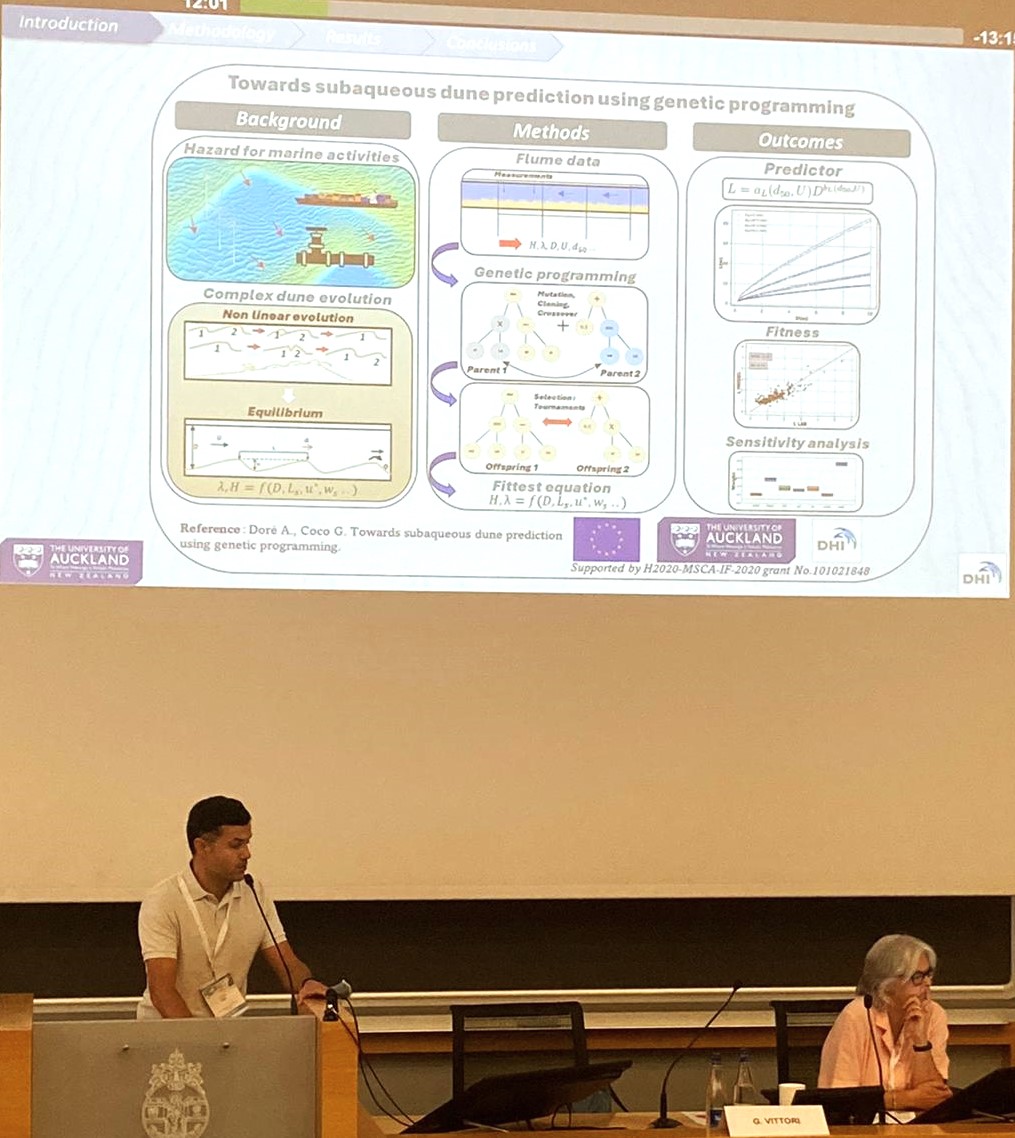
ICCE 2024, Pontifical Gregorian University, Rome
During ICCE 2024, I presented my research on genetic algorithms for subaqueous dune prediction. The conference provided an incredible platform to share my findings with a diverse and engaged audience of experts in coastal engineering. The feedback and discussions that followed my presentation were both insightful and encouraging, highlighting the potential impact of my work on the field.
PhD dissertation : Morphodynamic evolution of subaqueous sand dunes
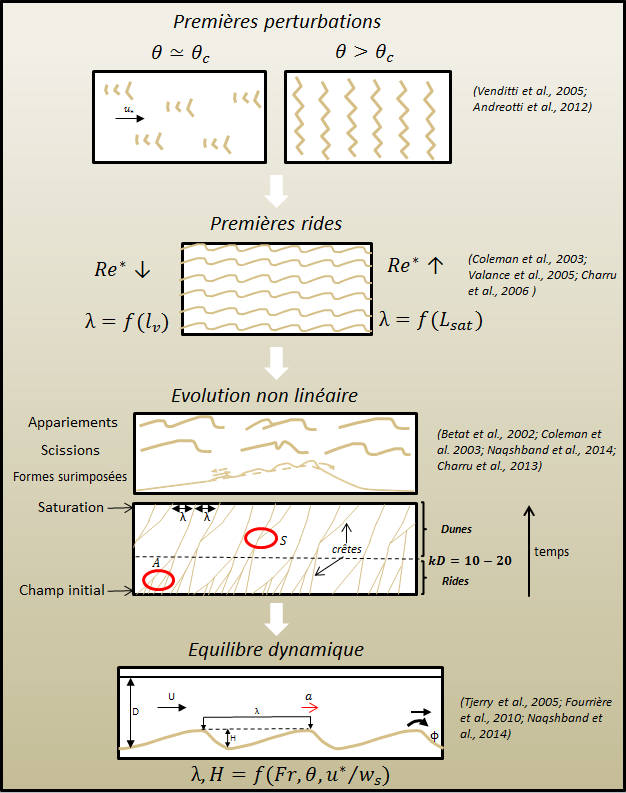

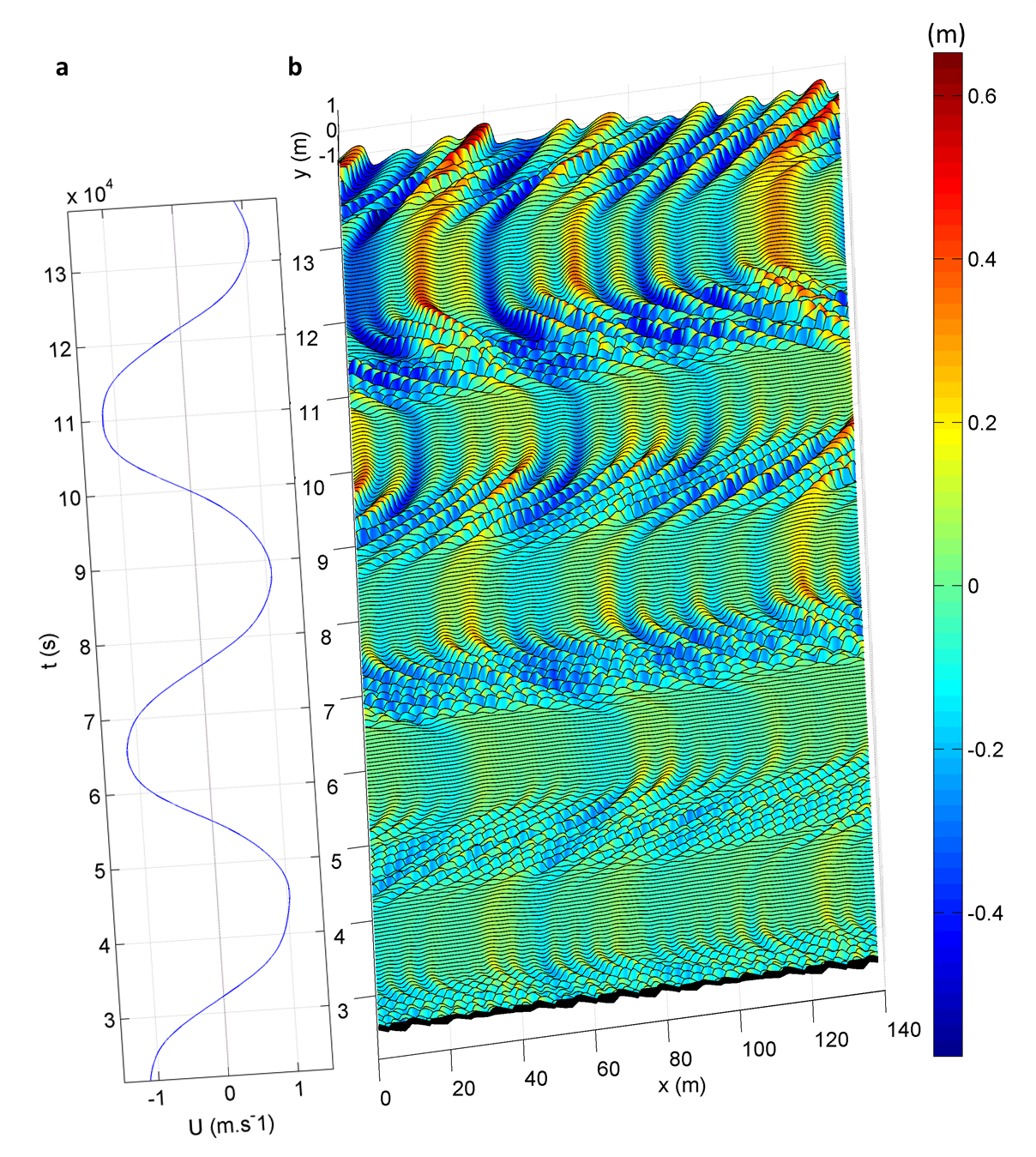
Summary : Sand dunes are ubiquitous beforms in nature within subaqueous environments. Understanding dune evolution is important issue to accurately predict the ow circulation, sediment uxes and bathymetric variations in sandy subaqueous environments. Sand dunes may pose a significant risk for offshore activities in coastal environments, especially with the growing development of renewable marine energy, for navigation or the offshore industry. Although sand dunes represent a great scientific and operational interest, their evolution is still poorly understood due to their complex behavior. The aim of the thesis work was to study the physical processes driving the evolution of subaqueous sand dunes and to understand their in situ dynamics within tidal environments. First, a numerical model was employed to simulate sand dunes under stationary current conditions. The simulations reproduced the morphodynamic evolution of a slightly perturbed bed until a steady sand dune field in equilibrium with the ow. The results offered a deeper understanding of the physical processes driving the bed evolution to equilibrium. Second, an array of in situ measurements was carried out into the Arcachon inlet, in southwest France, to study the dynamics of tidal sand dunes. For the first time their asymmetry and migration rates were linked to the sediment uxes residuals on a spring-neap tidal cycle. Finally, the numerical model was adapted both to simulate the dynamics of tidal sand dunes, and generate bedforms of the same order of magnitude as the in situ dune-superimposed ripples starting from a at bed. These results open promising perspectives for the development of a numerical tool capable of predicting the behavior of sand dunes within tidal environments.
Résumé de la thèse : Les objectifs principaux de ma thèse étaient la compréhension des processus d'évolution des formes sableuses de fond (dunes, rides, bancs de sable), la mise en place d'un modèle numérique, et l'observation des dunes tidales in situ. Le travail de thèse a été structuré en deux grandes parties, l'une concernant les dunes hydrauliques et l'autre les dunes tidales. L'étude des dunes hydrauliques a permis de dégager les principales inconnues concernant les processus d'évolution et de développer un modèle numérique capable de simuler leur évolution morphodynamique. Les observations conduites dans le bassin d'Arcachon ont apporté des informations importantes sur la dynamique des dunes tidales et des formes surimposées à différentes échelles temporelles. Le modèle a permis de reproduire l'évolution morphodynamique des dunes tidales avec les conditions de forçage mesurées dans la passe sud du bassin d'Arcachon. Lien : https://tel.archives-ouvertes.fr/tel-01285471/.

Nature based solutions / Solutions fondées sur la nature
Proposal sent to the Marsden Funds comitee in New Zealand for restoration of native reefs in the Bay of Auckland (May2023)
Sea level rise (SLR) is accelerating, and extreme storm events will occur more frequently by 2050 under all IPCC RCP* scenarios[1]. Annual coastal flood damages will increase by 2–3 orders of magnitude globally[2], affecting property, infrastructure, and damaging cultural and environmental sites[3]. In New Zealand (NZ), SLR is increasing faster due to land subsidence, up to a factor two [4]. Wave climate is changing rapidly, threatening NZ shorelines stability[5]. In response, ecosystems are suffering a loss of species habitat, biodiversity and functioning[6,7]. Anthropogenic stressors are responsible of a sharp decline of shellfish reefs, such as those created by oysters and mussels[8,9,10]. The reef-building green-lipped mussel endemic to New Zealand was almost completely destroyed by 1980 and have since not recovered[11,12]. Shellfish restoration projects are nowadays hindered by a scattered knowledge and a lack of evidence-based best practice [13,14,15]. An improved understanding of drag parameterization on reefs would benefit coastal managers exploring reef restoration as a strategy to protect shorelines from erosion [16].
The aim of our research project is to test the hypothesis that complex reef geometry -internal porosity and resistance elements- have a significant influence on wave and flow momentum fluxes dissipation that commonly used bulk drag coefficients underestimate. The outcome is to increase knowledge about nature-based methods (NBM) to support their use. We will rely on a strong NZ based and international team of experts and incorporate the iwi vision mātauranga of native ecosystems.
'Grey' engineering solutions in response to protecting coastal communities are becoming economically and ecologically unsustainable[17]. NBM is the creation or restoration of coastal habitats for hazard risk reduction[18,19,20,21]. Restored reefs are effective in protecting the shoreline and stabilizing the seafloor, besides providing benefitsthat support marine life[22,23,24]. Their restoration enhances water purification, biodiversity and carbon sequestration[25]. Pilot scale studies validated the efficacy of using small-scale experiments to test habitat suitability and optimize location selection to maximize efficiency of larger-scale restoration efforts [26,27].
We will adopt a three step-innovative methodology. First, we will perform flume measurements at the Fluid dynamics laboratory (FDL) of the University of Auckland (UoA) to test reefs under various hydrodynamic conditions. Reefs and species will be pre-selected among shellfish restoration projects that UoA is currently running with two iwi Ngāti Whātua Ōrākei and Ngāti Manuhiri. We will derive specific drag coefficients from flow measurements above and within 3D printed prototypes, using high resolution cameras synchronized with lasers, followed by Particle Image Velocimetry (PIV) analysis[28]. Second, we will introduce derived parametrizations into a RANS** model (XBEACH) to study effects of reef configurations on water levels and wave energy taking into account the ecological niche of shellfish species[22]. Time series of wave parameters will be used in a shoreline evolution model (Shorefor) tosimulate impacts on short- and long-term coastal equilibrium. We will work closely with Ngāti Whātua Ōrākei and Ngati Manuhiri iwi to implant tailored reef structures offshore an urban beach of significance in Auckland. UoA has experience of running the consent process for pilot restoration studies[25]. The shoreline evolution and reef development will be continuously monitored through regular beach surveys, to measure the impacts in terms of ecosystem restoration and shoreline stability. By unveiling fundamental hydrodynamics within complex reef structures, our research will generate unprecedented knowledge on reef-flow interactions. Our findings will have the potential to reinvent the paradigm of NZ shoreline management practices by providing a nature-based toolbox for coastal planners and authorities based on ecological reef design to improve coastal resilience.
* Representative Concentration Pathway
** Reynolds-Averaged Navier-Stokes
References :
- IPCC, 2022: Climate Change 2022: Impacts, Adaptation, and Vulnerability. Contribution of Working Group II to the Sixth Assessment Report of the Intergovernmental Panel on Climate Change [H.-O. Pörtner, D.C. Roberts, M. Tignor, E.S. Poloczanska, K. Mintenbeck, A. Alegría, M. Craig, S. Langsdorf, S. Löschke, V. Möller, A. Okem, B. Rama (eds.)]. Cambridge University Press. Cambridge University Press, Cambridge, UK and New York, NY, USA, 3056 pp., doi:10.1017/9781009325844.
- Tol, R. Economic impacts of climate change Rev. Environ. Econ. Policy, 12 (2018), pp. 4-25.
- Roberts, R., Carpenter, N. and Klinac, P. (2020). Predicting Auckland's exposure to coastal instability and erosion, Auckland Council, technical report, TR2020/021.
- Naish, T., Richard, H. Levy, Hamling, Ian James, et al. The significance of vertical land movements at convergent plate boundaries in probabilistic sea-level projections for AR6 scenarios: The New Zealand case. ESS Open Archive . July 13, 2022.
- Albuquerque, J, Antolínez, Jose A. A. , Méndez, Fernando J. & Coco, G. (2022) On the projected changes in New Zealand's wave climate and its main drivers, New Zealand. Journal of Marine and Freshwater Research, DOI: 10.1080/00288330.2022.2135116.
- Burke, L., Reytar, K., Spalding, M., and Perry, A. (2011). Reefs at Risk Revisited. Available online at: https://pdf.wri.org/reefs_at_risk_revisited.pdf.
- Pendleton, L. H., Hoegh-Guldberg, O., Langdon, C., & Comte, A. (2016). Multiple stressors and ecological complexity require a new approach to coral reef research. Frontiers in Marine Science, 3, 36.
- Beck, M. W., Brumbaugh, R. D., Airoldi, L., Carranza, A., Coen, L. D., Crawford, C., Defeo, O., Edgar, G. J., Hancock, B., Kay, M., Lenihan, H., Luckenbach, M. W., Toropova, C. L., & Zhang, G. (2009). Shellfish reefs at risk: A global analysis of problems and solutions.
- Gillies, C. L., McLeod, I. M., Alleway, H. K., Cook, P., Crawford, C., Creighton, C., Diggles, B., Ford, J., Hamer, P., Heller-Wagner, G., Lebrault, E., Le Port, A., Russell, K., Sheaves, M., & Warnock, B. (2018). Australian shellfish ecosystems: Past distribution, current status and future direction. PLoS One, 13, e0190914.
- Catton, C. A. (2019). Marine heat wave and multiple stressors tip bull kelp forest to sea urchin barrens. Scientific Reports, 9, 15050.
- Jeffs, A., Holland, R. C., Hooker, S. H., & Hayden, B. J. (1999). Overview and bibliography of research on the greenshell mussel, Perna canaliculus, from New Zealand waters. Journal of Shellfish Research, 18, 347–360.
- Paul, L. J. (2012). A history of the firth of Thames dredge fishery for mussels: Use and abuse of a coastal resource. New Zealand Aquatic Environment and Biodiversity Report No. 94.
- Bayraktarov, E., Brisbane, S., Hagger, V., Smith, C., Wilson, K., Lovelock, C., Gillies, C., Steven, A., Saunders, M. Priorities and motivations of marine coastal restoration research Front. Mar. Sci., 7 (2020), p. 484.
- Toone, T.A., Hunter, R, Benjamin, E., Handley, S., Jeffs, A., Hillman, J.R. 2021. Conserving shellfish reefs – a systematic evidence gap map of social and ecological outcomes of conservation actions. Restoration Ecology. 29: e13375.
- J. Deely, S. Hynes, J. Barquín, D. Burgess, G. Finney, A. Silió, J. Álvarez-Martínez, D. Bailly, J. Ballé-Béganton. Barrier identification framework for the implementation of blue and green infrastructures Land Use Policy, 99 (2020), Article 105108.
- Davis KA, Pawlak G, Monismith SG. Turbulence and Coral Reefs. Ann Rev Mar Sci. 2021 Jan;13:343-373. doi: 10.1146/annurev-marine-042120-071823. Epub 2020 Aug 7. PMID: 32762591.
- Hynes, S., Burger, R., Tudella, J., Norton, D., Chen, W. Estimating the costs and benefits of protecting a coastal amenity from climate change-related hazards: Nature based solutions via oyster reef restoration versus grey infrastructure, Ecological Economics, Volume 194, 2022, 107349, ISSN 0921-8009, https://doi.org/10.1016/j.ecolecon.2022.107349.
- Morris RL, Bishop MJ, Boon P, Browne NK, Carley JT, Fest BJ, Fraser MW, Ghisalberti M, Kendrick GA, Konlechner TM, Lovelock CE, Lowe RJ, Rogers AA, Simpson V, Strain EMA, Van Rooijen AA, Waters E, Swearer SE. (2021) The Australian Guide to Nature-Based Methods for Reducing Risk from Coastal Hazards. Earth Systems and Climate Change Hub Report No. 26. NESP Earth Systems and Climate Change Hub, Australia
- Scyphers, S., Powers, S., Heck, K. L., Byron, D. Oyster reefs as natural breakwaters mitigate shoreline loss and facilitate fisheries. PLoS One, 6 (2011), Article e22396.
- Cohen-Shacham et al., 2016 E. Cohen-Shacham, G. Walters, C. Janzen, S. Maginnis (Eds.), Nature-Based Solutions to Address Global Societal Challenges, IUCN, Gland, Switzerland (2016).
- Doré A., Deigaard R. Assessment of bed rock beach stability, numerical modelling. Prepared for C. D. Howe Company Ltd, 2019, 155 pp.
- Meyer et al., 1997 D. Meyer, E. Townsend, G. Thayer. Stabilization and erosion control value of oyster cultch for intertidal marsh. Restor. Ecol., 5 (1997), pp. 93-99.
- Reguero, B., Beck, M., Agostini, V., Kramer, P., Hancock, B. Coral reefs for coastal protection: a new methodological approach and engineering case study in Grenada. J. Environ. Manag., 210 (2018), pp. 146-161.
- Morris, RL., Konlechner, T., Ghisalberti, M., Swearer, S. From grey to green: efficacy of ecoengineering solutions for nature-based coastal defence. Glob. Chang. Biol., 24 (5) (2018), pp. 1827-1842.
- Opperman, J., Luster, R., McKenney, B., Roberts, M., Meadows, A. Ecologically functional floodplains: connectivity, flow regime, and scale. J. Am. Water Resour. Assoc., 46 (2) (2010), pp. 211-226.
- Benjamin, E. D., Handley, S. J., Jeffs, A., Olsen, L., Toone, T. A., & Hillman, J. R. (2023). Testing habitat suitability for shellfish restoration with small-scale pilot experiments. Conservation Science and Practice, 12878. https://doi.org/10.1111/csp2.12878.
- Wilcox, M., Kelly, S., & Jeffs, A. (2018). Ecological restoration of mussel beds onto soft-sediment using transplanted adults. Restoration Ecology, 26, 581–590.
- Thielicke, W. and Stamhuis, E.J., 2014. PIVlab – Towards User-friendly, Affordable and Accurate Digital Particle Image Velocimetry in MATLAB. Journal of Open Research Software, 2(1), p.e 30. DOI: https://doi.org/10.5334/jors.bl.
